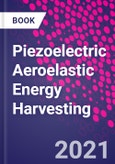Piezoelectric Aeroelastic Energy Harvesting explains the design and implementation of piezoelectric energy harvesting devices based on fluid-structure interaction. There is currently an increase in demand for low power electronic instruments in a range of settings, and recent advances have driven their energy consumption downwards. As a result, the possibility to extract energy from an operational environment is of growing significance to industry and academic research globally.
This book solves problems related to the integration of smart structures with the aeroelastic system, addresses the importance of the aerodynamic model on accurate prediction of the performance of the energy harvester, describes the overall effect of the piezoelectric patch on the dynamics of the system, and explains different mechanisms for harvesting energy via fluid-structure interaction. This wealth of innovative technical information is supported by introductory chapters on piezoelectric materials, energy harvesting and circuits, and fluid structure interaction, opening this interdisciplinary topic up for readers with a range of backgrounds.
Please Note: This is an On Demand product, delivery may take up to 11 working days after payment has been received.
Table of Contents
Part I Introduction
1. Piezoelectric Materials
2. Smart structures
3. Fluid-Structure Interaction
Part II Energy Harvesting
4. Energy harvesting
5. Piezoelectric energy harvesters
6. Energy harvesting and circuits
7.�Modelling and�simulation of a�piezoelectric energy harvester
Part III Aeroelastic Energy Harvesting
8. Flutter-based aeroelastic energy harvesting
9. Limit cycle oscillations
10. Vortex-induced vibrations based aeroelastic�energy harvesting
11. Gallooping-based aeroelastic energy harvesting
12. Experimental aeroelastic energy harvesting
13. Concluding remarks
Authors
Hassan Elahi Department of Mechanical and Aerospace Engineering, Sapienza University of Rome, Italy; Assistant Professor, Department of Mechatronics Engineering, National University of Science and Technology, Pakistan. Dr Hassan Elahi is a Mechatronics Engineer and has completed his PhD from the Department of Mechanical and Aerospace Engineering, Sapienza University of Rome, Italy. He has worked as a Research Associate in the same department. His PhD research thesis was on "Piezoelectric Energy Harvesting by Aeroelastic Means.� Currently he is working as an Assistant Professor at Department of Mechatronics Engineering, National University of Science and Technology, Pakistan. He has obtained Award of Honors in his master's degree. Dr. Elahi has received best paper award related to energy harvesting system for mechatronics devices in 2018 by MDPI. Marco Eugeni Department of Mechanical and Aerospace Engineering, Sapienza University of Rome, Italy. Dr. Marco Eugeni holds a Master's degree in Space Engineering and PhD in Aerospace Materials and Technologies at Sapienza University of Rome, 2014. Since 2014 he has been an Associate Researcher at Dept. of Mechanical and Aerospace Engineering (DIMA). He is aParticipant in various ESA project concerning the Vega launcher and Industry 4.0 applications to Satellite Industry, and since 2016, a consultant to Smart Structures Solutions directly involved in the main experimental campaign carried on. Dr. Eugeni's research topics concentrate in computational mechanics and finite element, aerospace structures, composite structures, thermal structures, intelligent materials and structures, aeroelasticity, viscoelastic materials modeling, structural dynamics, additive manufacturing, and smart manufacturing. Paolo Gaudenzi Full Professor and Director of the Professional Master in Satellites and orbital platforms, director of the Dipartimento di Ingegneria Meccanica e Aerospaziale (Department of Mechanical and Aerospace Engineering), Universit� di Roma La Sapienza.. Dr. Paolo Gaudenzi is a PhD in Aerospace Engineering, Universit� di Roma La Sapienza (1989). He is an expert in the evaluation of research projects for the Italian Ministry for Education, University and Research, the Italian Ministry for Industrial development, The European Research Council, the regions Lazio, Toscana, Veneto, Piemonte, Puglia; and the Chairman of the selection board for ENEA (National research body in the field of energy and power). Dr. Gaudenzi is the author of more than 100 papers, 44 of which published on international refereed journals, and of the research book Smart structures, J. Wiley 2009. His reseach interests are aerospace structures, space systems, concurrent engineering and multidisciplinary methods for engineering design, cost engineering, laminated and composite structures, active materials and intelligent structures, thermal structures, finite element modelling, multyphisics analysis.








